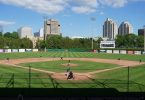Several years ago Baseball Ontario adopted the 30/30 Rule for lightning safety.
Based on Environment Canada, Baseball Ontario has updated the 30/30 rule to accurately read as follows,: “If you can count 30 seconds or less between the lightning flash and hearing the thunder, immediately take shelter and stay there until 30 minutes after the last rumble of thunder.”
Players, coaches, umpires, spectators, etc. should immediately seek shelter if the 30/30 rule is in place, preferably an all-metal automobile (not convertible top) or a building with running water and electricity. If caught outside far from a safe shelter, stay away from tall objects, such as trees, poles, wires and fences. Take shelter in a low lying area.
Environment Canada states “it’s not necessarily the direct lightning strike that will injure or kill a player. During a lightning storm the atmosphere becomes electrified. Lightning streamers from the ground are trying to connect up with the lightning strike making its way from the cloud to the ground. If these streamers form on a fence/lamp post or even a player, damage can occur to a player’s nervous system and brain making them unfit to play. People can recover from this close encounter with lightning but some damage can last a lifetime.”
While the 30/30 rules provides a timeline to protect oneself during a thunderstorm while participating in an outdoor activity, in 2011,Environment Canada adopted a much clearer statement. “When thunder roars, GO INDOORS” or in French “Quand le tonnerre gronde, RENTREZ VITE!”
The following video focuses on soccer players but could easily be applied to baseball players.
http://www.ec.gc.ca/foudre-lightning/default.asp?lang=En&n=54B219E5-1
Environment Canada also provides tools to help you with your decision of when to play or when to suspend or cancel practices/games. The Canadian Lightning Danger Map (CLDM) which is available on mobile devices. http://weather.gc.ca/lightning/index_e.html.
This map shows red areas that are most at risk of having lightning strike the ground in the next 10 minutes. Please view the short video describing how to use it at the following link.
http://www.ec.gc.ca/foudre-lightning/default.asp?lang=En&n=1EC15260-1
The updated 30/30 rule can be located on the Baseball Ontario web page, along with the links listed in this notification:
http://www.baseballontario.com/Admin/SideMenu/DispSideMenuContentMain.aspx?TopMenuID=10001&menuID=363&dipIds=undefined
Regards,
The Risk Management Committee
Baseball Ontario







